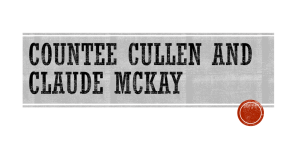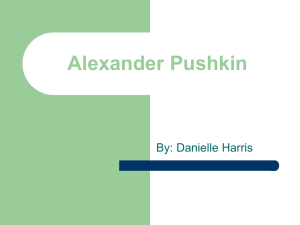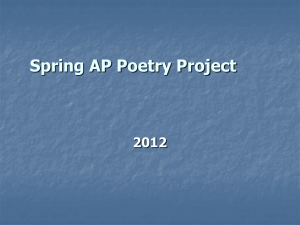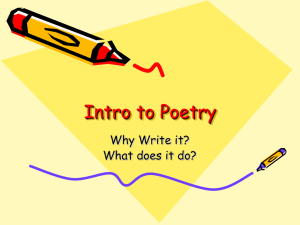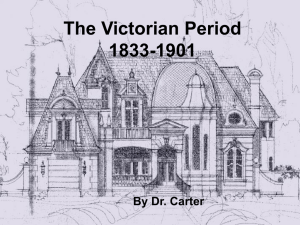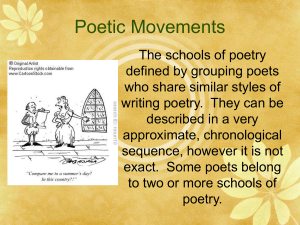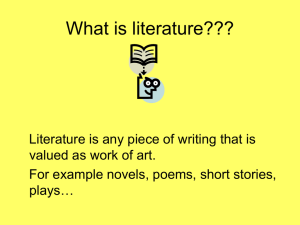An Introduction to British Literature - Yola
advertisement
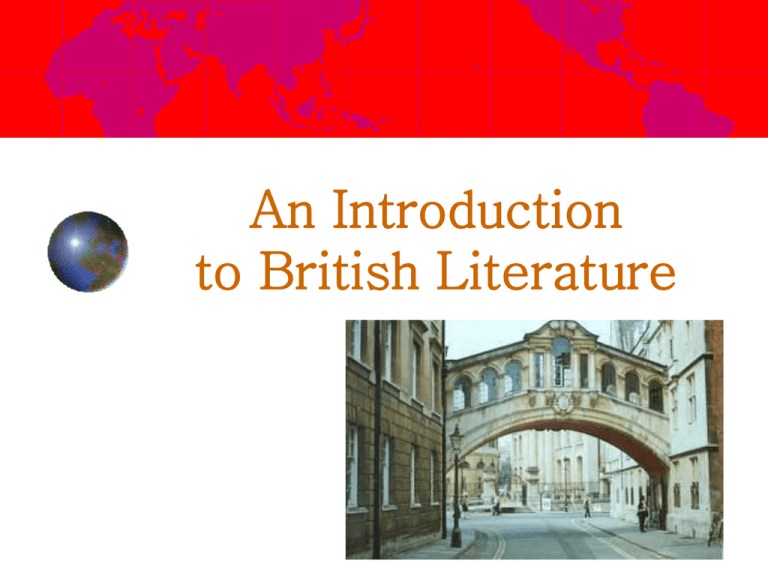
An Introduction to British Literature An Overall View of British Literature Early and Medieval English Literature Elizabethan Drama The 17th Century The 18th Century The Romantic Period The 19th Century novels The Twentieth Century Early and Medieval English Literature Old English Literature Medieval English Literature Old English Literature Anglo-Saxon Poetry Romance Anglo-Saxon Poetry English literature began with the Anglo-Saxon settlement in England. Beowulf: The first piece of English literary work The national epic of the English people A long poem of over 3,000 lines Features of Beowulf: Alliteration Metaphors Anglo-Saxon Poetry Beowulf: The story consists of three fights made by Beowulf, the hero in the story. 1) The fight with the monster Grendel 2) The fight with Grendel’s mother 3) The fight with a fire Dragon Alliteration The most striking feature in Beowulf is the use of alliteration. In alliterative verse, certain accented words in a line begin with the same consonant sound. examples: Of men he was the mildest and most beloved, To his kin the kindest , keenest to praise. (In modern translation) Metaphor Ring-giver is used for King Hearth-companions for his attendant warriors Swan’s bath / whale’s road for sea Sea-wood for ship Such metaphors occur in great numbers in this work. Romance The most prevailing kind of literature in feudal England A long composition describing the life and adventures of a noble hero Central character – the knight Theme – loyalty to king and his lord Adventure of King Arthur and his Knights of the Round Table Sir Gawain and the Green Knight Medieval English Literature Geoffrey Chaucer (1343-1400) Chaucer’s Literary Career Chaucer’s Contribution Geoffrey Chaucer founder of English poetry He was the son of a wine merchant. He went to France at 19 on one of the campaigns of the Hundred Year’s War and was taken prisoner. Several times he was sent to the European Continent on diplomatic missions, two of which took him to Italy. He was buried in Westminster Abbey, thus founding the Poet’s Corner. Chaucer’s Literary Career The first period/ works translated from French La Romaunt de la Rose/ the Romance of the Rose The second period/ works adapted from the Italian Troilus and Criseyde The third period/ works of purely English The Canterbury Tales The Canterbury Tales Chaucer’s masterpiece and one of the monumental works in English literature Outline of the story The tales: The Wife of Bath next Outline of the story back The whole poem is a collection of stories . On a spring evening, the poet, moved by the passion for wandering, drops himself at the Tabard Inn. Here he meets 29 other pilgrims ready for a journey on horseback to Canterbury. Chaucer’s Contribution He introduced from France the rhymed stanza of various types, especially the rhymed couplet of 5 accents in iambic meter/ heroic couplet He is the first great poet who wrote in the English language. He established English as the literary language of the country. He did much in making the dialect of London the standard for the modern English speech. Elizabethan Drama Renaissance Christopher Marlowe William Shakespeare back Renaissance Renaissance is an intellectual movement or the rebirth of the letters. It sprang first in Italy in the 14th century and gradually spread all over Europe. Two features are striking of this movement: Features of Renaissance back 1. There is a thirsting curiosity for the classical literature. There arose a current for the study of Greek and Latin authors. 2. Another feature of the Renaissance is the keen interest in the activities of humanity. People ceased to look upon themselves as living only for God and a future world. Features of Renaissance Thinkers, artists and poets had a new feeling of admiration for human beauty and human achievement. A feeling in sharp contrast with theology. Hence arose the thought of Humanism. Humanism is the key-note of the Renaissance. Christopher Marlowe Christopher Marlowe (1564–1593) was an English dramatist, poet and translator of the Elizabethan era. He is known for his magnificent blank verse, his overreaching protagonists, and his own mysterious and untimely death. Christopher Marlowe “University Wits” The Tragical History of Doctor Faustus University Wits back Numberless playwrights, amateur or professional, wrote for the actors. There was a group called “university wits”. They wrote for the stage of the time, they were all of humble birth and struggled for a livelihood through writing. The most gifted playwright in the “university wits” is Christopher Marlowe. The Tragical History of Doctor Faustus next 1. It is based on a German legend. The hero of the play is Doctor Faustus, a young and brilliant scholar. The chief feature of his character is a thirst for knowledge. Faustus takes one by one the chief subjects of academic curriculum, philosophy, medicine and law. He is bored with the orthodox curriculum, and turns to the study of magic in order to understand and possess the kingdoms of the earth. Then he meet the Devil and the doctor must sell his soul to the Devil so he may live 24 years, with the Devil at his command. Then Faustus signs the bond with his own blood. The Tragical History of Doctor Faustus back After the contract with the Devil, Faustus makes a tour in the universe on a dragon’s back. Then he gives a display of his magic art and plays tricks upon the Pope at a banquet. Meanwhile Faustus is drawing near his doom. It is the scholars who are his companions on his last night on earth. Even in his painful expectation of the coming of the devils, he thinks of his friends safety: “ Gentlemen, away, lest you perish with me.” So one hour before midnight, Faustus is left to face his awful destiny alone until he is carried away by the Devil. William Shakespeare William Shakespeare (1564–1616) was an English poet and playwright, widely regarded as the greatest writer in the English language and the world's preeminent dramatist. He is often called England's national poet and the "Bard of Avon" (or simply "The Bard"). William Shakespeare His surviving works consist of 38 plays, 154 sonnets, two long narrative poems, and several other poems. His plays have been translated into every major living language, and are performed more often than those of any other playwright. Historical plays Great comedies Great tragedies William Shakespeare Historical plays: Henry Ⅳ Richard III Henry Ⅴ Henry VIII back William Shakespeare Great comedies: The Merchant of Venice As You Like It Twelfth Night A Midsummer Night’s Dream back William Shakespeare Great tragedies: Hamlet Othello King Lear Macbeth back William Shakespeare Shakespeare’s Birthplace The 17th Century English Literature King James Bible Francis Bacon John Milton King James Bible The authorized version of English Bible was finished under the supervision of King James, so it is called King James Bible. The authorized version has had a great influence on English language and literature. About 93% of the words used in it are the main words of native English. So with the widespread influence of the English Bible, the standard modern English has been fixed and confirmed. A great number of Bible phrases have passed into daily English speech as household words. Francis Bacon He is the founder of English materialist philosophy, founder of modern science in England and the first English essayist. His works: Essays (Of Study, Of Truth) New Instrument Advancement of Learning Of Study Studies serve for delight, for ornament, and for ability. Reading makes a full man; conference a ready man; and writing an exact man. Histories make men wise; poets witty; the mathematics subtle; natural philosophy deep; moral grave; logic and rhetoric able to contend. Of Study 读书足以怡情, 足以博采, 足以长才. 读书使人充实,讨论使人机智,笔记使人准确。 读史使人明智,读诗使人灵秀,数学使人周密, 科学使人深刻,伦理学使人庄重,逻辑修辞使 人善辩 John Milton About the author About Paradise Lost Major works John Milton With the Restoration of Charles II, Milton was arrested and imprisoned. His book were burnt. But he was saved, he probably owed his escape from death to his blindness. A fire in London destroyed his house. He moved from place to place until he settled down on the outskirts of London. His blindness forced him to depend on his daughters for an assistance with his reading and writing. Everyday he dictated his epic Paradise Lost 10 or 20 lines at a time. Paradise Lost It is a long epic of 12 books. The story was taken from the Bible. The Old Testament The New Testament The story was taken from the Old Testament, the Creation. Paradise Lost Content: 1. the rebellion of Satan and his fellow-angles in Heaven. 2. the Creation of the earth and of Adam and Eve by God. 3. Satan’s temptation of Eve and the departure of Adam and Eve from the Garden of Eden. Paradise Lost Satan and his followers are banished from Heaven and driven into the hell. Satan fearlessly withstands all pains and passionately strives for victory. He choose for his battlefield the most perfect spot ever created by God--the Garden of Eden, where live the first man and woman--Adam and Eve. They were not permit to eat the fruit that grows on the Tree of Knowledge. Paradise Lost Satan persuade her to break God’s command, Eve eats an apple from the forbidden tree and pick for Adam. Adam and Eve were expelled from the Garden of Eden and doomed to an earthly life full of hardships and sufferings. John Milton His masterpiece: Paradise Lost Paradise Regained Samson Agonist back The 18th Century English Literature Historical and social Background The 18th century is a period of comparatively peaceful development in England. After the Glorious Revolution, England entered the Golden Age. The state power passed from the king gradually to the Parliament and the cabinet ministers; therefore, capitalist system was established in England. A vast expansion abroad of British colonies in Asia, Africa and North America and Acts of Enclosure at home caused the Industrial Revolution. The th 18 Century English Literature Cultural Background The Enlightenment Movement The 18th-century England is known as the Age of Enlightenment or the Age of Reason. The Enlightenment Movement was a progressive intellectual movement which flourished in France & swept through the whole Western Europe at the time. The movement was a furtherance of the Renaissance of the 15th & 16th centuries. The 18th Century English Literature The development of the literature in this period can be summarized as: the predominance of neoclassical poetry and prose in the early decades of the 18th century; the rise and flourish of modern realistic novel in the middle years of the 18th century; and the appearance of gothic novel and the sentimental and pre-romantic poetry and fiction in the last few decades of the 18th century. The 18th Century English Literature Jonathan Swift Daniel Defoe Pre-Romanticism Robert Burns & William Blake Jonathan Swift Jonathan Swift (1667–1745) was an AngloIrish satirist, essayist, political pamphleteer (first for Whigs then for the Tories) and poet. Swift is probably the foremost prose satirist in the English language, and is less well known for his poetry. Swift originally published all of his works under pseudonyms or anonymously. He is also known for being a master of satire. Jonathan Swift His major works: A Tale of a Tub Gulliver’s Travels A Modest Proposal A Tale of a Tub This book is written in the form of a parable, an old man died and left a coat, i.e. the Christian doctrine, to each of his three sons, Peter, Martin and Jack. The three sons stand for Roman Catholics, Protestants and Puritans. They evade their father’s will, interpret it each in his own way, and change the fashion of their garment. This is a satire upon all religious sects. Swifts satire becomes an attack on Christianity itself. Gulliver’s Travels The First Voyage In the first part Gulliver describes his shipwreck in Lilliput where the tallest people were 6 inches high. The two parties in this country were distinguished by the use of high and low heels, Swift satirizes the Tories and the Whigs in England. Religious disputes were laughed at in account of a problem which divided the people: “Should eggs be broken at the big end or the little end?” Gulliver’s Travels The Second Voyage The voyage to Brobdingnag is described in this part. Gulliver now found himself a dwarf among men 60 feet in height. The King regarded Europe as if it were an anthill. The Third Voyage The third part is a satire on philosophers and projectors who were given to dwelling in the air, like the inhabitants of the Flying Island. Gulliver’s Travels The Fourth Voyage In the last part, Gulliver’s satire is of the bitterest. Gulliver was now in a country where horses were possessed of reason, and were the governing class, while the Yahoos, though in the shape of men, were brute beasts with such vices as stealing and lying. This work gives an satirical depiction of the vices of his age. Daniel Defoe Daniel Defoe (1659/1661 [?]—1731[?]) was an English writer, journalist, and pamphleteer, who gained enduring fame for his novel Robinson Crusoe. Defoe is notable for being a prolific and versatile writer, he wrote more than five hundred books, pamphlets, and journals on various topics (including politics, crime, religion, marriage, psychology and the supernatural). Daniel Defoe His works: Moll Flanders Captain Singleton Robinson Crusoe Robinson Crusoe When Robinson is 19, he runs away from home and sets out to sea. After many adventures on the sea, he settles down in Brazil. But the call of the sea is so strong that he embarks on another voyage to Africa. A frightful storm changes the course of the ship and it is wrecked off the coast of an uninhabited island. Of all the ship’s crew Robinson alone escapes to the shore. Robinson Crusoe He spends the night on a tree for fear of wild animals. He set up a tent, he plants barley and corn, and harvests crops in time. He spend many months of hard toil in shaping a stonemortar. It takes Robinson over five months to fell a big tree and fashion it into a boat. But great is his disappointment when he is unable to shift the heavy boat to the sea. Robinson’s will-power in bettering his living conditions is amazing, strong winds, rains and earthquakes do not stop him from attaining his once set resolutions. Robinson Crusoe Many years go by. One day Robinson discovers the imprint of a man’s foot on the sand. Then he learns that the island is occasionally visited by some cannibals who come to celebrate their victories over their enemies and to eat their captives. Robinson happens to see one such celebration and manages to save one of the victims, this man, named Friday by Robinson, proves to be a clever young Negro. An English ship drops anchor off the island, the captain takes Robinson and Friday to England. Robert Burns Robert Burns (1759–1796) was a poet and a lyricist. He is widely regarded as the national poet of Scotland, and is celebrated worldwide. He is the best known of the poets who have written in the Scots language, although much of his writing is also in English and a 'light' Scots dialect, accessible to an audience beyond Scotland. Robert Burns Major works: My Heart’s in the High Land A Red Red Rose Holy Willie’s Prayer To a Mouse To a Louse William Blake William Blake (1757– 1827) was an English poet, painter, and printmaker. His major works: Songs of Innocence Songs of Experience Romantic Period Roughly the first third of the 19th century. Writers of romantic literature are more concerned with imagination and feeling than with the power of reason. The glory of the age is notably seen in the Poetry of Wordsworth, Coleridge, Byron, Shelley and Keats, who were grouped into two generations: Romantic Period Passive poets/ Lake poets William Wordsworth Samuel Taylor Coleridge Robert Southey Active poets George Gordon Byron Percy Bysshe Shelley John Keats Lake Poets Lake Poets The three poets have often been mentioned as the “Lake Poets”. Because they lived in the Lake District in the northwestern part of England. The three traversed the same path in politics and in poetry, beginning as radicals and closing as conservatives. William Wordsworth He is the representative poet of the early Romanticism. Like other Romantics, Wordsworth’s personality and poetry were deeply influenced by his love of nature, especially by the sights and scenes of the Lake Country, in which he spent most of his mature life. A profoundly earnest and sincere thinker, he displayed a high seriousness tempered with tenderness and a love of simplicity. William Wordsworth His works: Lyrical Ballads To the Cuckoo Lines Written in Early Spring I Wandered Lonely as a Cloud Lucy Poems Samuel Taylor Coleridge Samuel Taylor Coleridge (1772–1834) was an English poet, critic and philosopher who was, along with his friend William Wordsworth, one of the founders of the Romantic Movement in England and one of the Lake Poets. He is probably best known for his poems The Rime of the Ancient Mariner, as well as his major prose work Biographia Literaria. Samuel Taylor Coleridge Robert Southey Robert Southey (1774–1843) was an English poet of the Romantic school, one of the socalled "Lake Poets", and Poet Laureate for 30 years from 1813 to his death in 1843. He was a prolific letter writer, literary scholar, essay writer, historian and biographer. Perhaps his most enduring contribution to literary history is the immortal children's classic, The Story of the Three Bears, the original Goldilocks story, which first saw print in 1834 in Southey's novel, The Doctor. Robert Southey George Gordon Byron George Gordon Byron (1788–1824) was a British poet and a leading figure in Romanticism. He is regarded as one of the greatest European poets and remains widely read and influential, both in the English-speaking world and beyond. Byron's fame rests not only on his writings but also on his life, which featured extravagant living, numerous love affairs, debts, separation, and marital exploits. He was famously described by Lady Caroline Lamb as "mad, bad, and dangerous to know." George Gordon Byron His major works: Child Harold’s Pilgrimage Don Juan Percy Bysshe Shelley Percy Bysshe Shelley (1792–1822) was one of the major English Romantic poets and is widely considered to be among the finest lyric poets in the English language. He was famous for his association with John Keats and Lord Byron. The novelist Mary Shelley was his second wife. Percy Bysshe Shelley His major works: Prometheus Unbound A Defence of Poetry Ode to the West Wind The Revolt of Islam Percy Bysshe Shelley The trumpet of a prophecy ! O, Wind, If winter comes, can Spring be far behind? John Keats John Keats (1795–1821) was one of the principal poets of the English Romantic movement. During his short life, his work received constant critical attacks from periodicals of the day, but his posthumous influence on poets has been immense. Elaborate word choice and sensual imagery characterize Keats's poetry. John Keats Major works: Isabella The Eve of St. Agnes, Lamia Ode to a Nightingale 19th Century Novels Mary Shelley Walter Scott Jane Austen Bronte Sisters Charles Dickens William Makepeace Thackeray Thomas Hardy Mary Shelley Mary Shelley (1797–1851) was a British novelist, short story writer, dramatist, essayist, biographer, and travel writer. She also edited and promoted the works of her husband, the Romantic poet and philosopher Percy Bysshe Shelley. Mary Shelley Her works: Gothic novel Frankenstein: or, The Modern Prometheus (1818) Walter Scot Sir Walter Scott(1771 – 1832) was a prolific Scottish historical novelist and poet popular throughout Europe during his time. His novels and poetry are still read, and many of his works remain classics of both Englishlanguage literature and of Scottish literature. Famous titles include Ivanhoe, Rob Roy, The Lady of The Lake, Waverley, The Heart of Midlothian and The Bride of Lammermoor. Walter Scot Jane Austen Her major works: Pride and Prejudice Sense and Sensibility Emma Northanger Abbey Mansfield Park Persuasion Jane Austen Jane Austen(1775-1817), is a famous English novelist. With detail, Austen portrayed the quiet, day-to-day life of members of the upper middle class. Her works combine romantic comedy with social satire and psychological insight. The Bronte Sisters The Brontë sisters, Charlotte (1816–1855), Emily (1818–1848) and Anne (1820– 1849), were English writers of the 1840s and 1850s. Their novels caused a sensation when they were first published and were subsequently accepted into the canon of great English literature. The Bronte Sisters Charlotte Bronte Jane Eyre The Professor Emily Bronte Wuthering Heights Anne Bronte Agnes Grey The Tenant of Wildfell hall The Bronte Sisters The Brontë sisters, painted by their brother Branwell, c. 1834. From left to right: Anne, Emily and Charlotte (there still remains a shadow of Branwell, which appeared after he painted himself out). Charles Dickens Charles John Huffam Dickens(1812–1870), pen-name "Boz", was one of the most popular English novelists of the Victorian era. Many of Dickens's novels first appeared in periodicals and magazines in serialized form. Unlike many other authors who completed entire novels before serial production commenced, Dickens often composed his works in parts, in the order in which they were meant to appear. Such a practice lent his stories a particular rhythm. Charles Dickens His Major works: Oliver Twist A Tale of Two Cities Great Expectations David Copperfield Charles Dickens William Makepeace Thackeray William Makepeace Thackeray (1811–1863) was an English novelist of the 19th century. He was famous for his satirical works, particularly Vanity Fair, a panoramic portrait of English society. His major works : Vanity Fair ----- A novel without a hero William Makepeace Thackeray Robert Louis Stevenson Robert Louis Balfour Stevenson (1850– 1894), was a Scottish novelist, poet, essayist and travel writer. He was the man who "seemed to pick the right word up on the point of his pen, like a man playing spillikins.” Stevenson was greatly admired by many authors. Robert Louis Stevenson His works: Treasure Island (1883) Strange Case of Dr Jekyll and Mr Hyde (1886) Kidnapped (1886) Thomas Hardy Thomas Hardy(1840– 1928) was an English novelist, short story writer, and poet of the naturalist movement, though he saw himself as a poet and wrote novels mainly for financial gain only. Thomas Hardy His Major works: Tess of the D’urbervilles Under the Greenwood Tree Far from the Madding Crowd Major of Casterbridge Jude the Obscure The th 20 Century Literature Modernism Joseph Conrad Virginia Woolf D. H. Lawrence E. M. Forster T. S. Eliot William Butler Yeats Oscar Wilde Joseph Conrad Joseph Conrad (1857–1924) was a Polishborn English novelist. Many critics regard him as one of the greatest novelists in the English language. He became a naturalized British subject in 1886. Conrad is recognized as a master prose stylist. Some of his works have a strain of romanticism, but more importantly he is recognized as an important forerunner of modernist literature. Joseph Conrad His works: The Heart of Darkness (1902) Virginia Woolf Virginia Woolf (1882–1941) was an English novelist and essayist, regarded as one of the foremost modernist literary figures of the twentieth century. During the interwar period, Woolf was a significant figure in London literary society and a member of the Bloomsbury Group. Virginia Woolf The Bloomsbury Group was an English collectivity of friends and relatives who lived in or near London during the first half of the twentieth century. Their work deeply influenced literature, aesthetics, criticism, and economics as well as modern attitudes towards feminism, pacifism, and sexuality. Its best known members were Virginia Woolf, John Maynard Keynes, E. M. Forster, and Lytton Strachey. Virginia Woolf She sometimes used the “stream of consciousness” technique. ▶Stream of Consciousness is a psychological term indicating the flux of conscious and subconscious thoughts and impressions moving in the mind at any given time independently of the person’s will. ▶In the 20th century, under the influence of Fleud’s theory of psychological analysis , a number of writers adopted the Stream of Consciousness as a method of novel writing. Virginia Woolf Virginia Woolf Her most famous works include the novels Mrs Dalloway (1925), To the Lighthouse (1927) and Orlando (1928), and the book-length essay A Room of One's Own (1929), with its famous dictum, "a woman must have money and a room of her own if she is to write fiction." D. H. Lawrence David Herbert Richards Lawrence (1885 – 1930) was an English writer of the early 20th century, whose prolific and diverse output included novels, short stories, poems, plays, essays, travel books, paintings, translations, and literary criticism. His collected works represent an extended reflection upon the dehumanizing effects of modernity and industrialization. In them, Lawrence confronts issues relating to emotional health and vitality, spontaneity, human sexuality and instinct. D. H. Lawrence Lawrence is perhaps best known for his novels Sons and Lovers, The Rainbow, Women in Love and Lady Chatterley's Lover. E. M. Forster Edward Morgan Forster(1879–1970), was an English novelist, short story writer, essayist, and librettist. He is known best for his ironic and wellplotted novels examining class difference and hypocrisy in early 20thcentury British society. E. M. Forster His works: A Room with a View (1908) Howards End (1910) A Passage to India (1924) Others T. S. Eliot William Butler Yeats Oscar Wilde The 20th Century Literature Postmodernism George Orwell John Fowles Graham Greene

